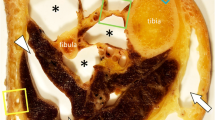Abstract
The layers of loose connective tissue within deep fasciae were studied with particular emphasis on the histochemical distribution of hyaluronan (HA). Samples of deep fascia together with the underlying muscles were taken from neck, abdomen and thigh from three fresh non-embalmed cadavers. Samples were stained with hematoxylin–eosin, Azan-Mallory, Alcian blue and a biotinylated HA-binding protein specific for HA. An ultrasound study was also performed on 22 voluntary subjects to analyze the thickness of these deep fasciae and their sublayers. The deep fascia presented a layer of HA between fascia and the muscle and within the loose connective tissue that divided different fibrous sublayers of the deep fascia. A layer of fibroblast-like cells that stained prominently with Alcian blue stain was observed. It was postulated that these are cells specialized for the biosynthesis of the HA-rich matrix. These cells we have termed “fasciacytes”, and may represent a new class of cells not previously recognized. The ultrasound study highlighted a mean thickness of 1.88 mm of the fascia lata, 1.68 mm of the rectus sheath, and 1.73 mm of the sternocleidomastoid fascia. The HA within the deep fascia facilitates the free sliding of two adjacent fibrous fascial layers, thus promoting the normal function associated with the deep fascia. If the HA assumes a more packed conformation, or more generally, if the loose connective tissue inside the fascia alters its density, the behavior of the entire deep fascia and the underlying muscle would be compromised. This, we predict, may be the basis of the common phenomenon known as “myofascial pain.”





Similar content being viewed by others
References
Benetazzo L, Bizzego A, De Caro R, Frigo G, Guidolin D, Stecco C (2011) 3D reconstruction of the crural and thoracolumbar fasciae. Surg Radiol Anat. doi:10.1007/s00276-010-075-7
Bhattacharya V, Barooah PS, Nag TC, Chaudhuri GR, Bhattacharya S (2011) Detail microscopic analysis of deep fascia of lower limb and its surgical implication. Indian J Plast Surg 43:135–140
Bhattacharya V, Chaudhuri GR, Mishra B, Kumar U (2011) Demonstration of live lymphatic circulation in the deep fascia and its implication. Eur J Plast Surg 34:99–102. doi:10.1007/s00238-010-0474-9
Chang SK, Gu Z, Brenner MB (2010) Fibroblast-like synoviocytes in inflammatory arthritis pathology: the emerging role of cadherin-11. Immunol Rev 233:256–266
Entwistle J, Hall CL, Turley EA (1996) HA receptors: regulators of signalling to the cytoskeleton. J Cell Biochem 61:569–577. doi:10.1002/(SICI)1097-4644(19960616)61:4<569:AID-JCB10>3.0.CO;2-B
Feinberg RN, Beebe DC (1983) Hyaluronate in vasculogenesis. Science 220:1177–1179. doi:10.1126/science.6857242
Fraser JR, Laurent TC, Laurent UB (1997) Hyaluronan: its nature, distribution, functions and turnover. J Intern Med 242:27–33. doi:10.1046/j.1365-2796.1997.00170.x
Graven-Nielsen T, Mense S, Arendt-Nielsen L (2004) Painful and non-painful pressure sensations from human skeletal muscle. Exp Brain Res 159:273–283. doi:10.1007/s00221-004-1937-7
Laurent C, Johnson-Wells G, Helstrom S, Engstrom-Laurent A, Wells AF (1991) Localization of hyaluronan in various muscular tissues. A morphologic study in the rat. Cell Tissue Res 263:201–205. doi:10.1007/BF00318761
Lancerotto L, Stecco C, Macchi V, Porzionato A, Stecco A, De Caro R (2011) Layers of the abdominal wall: anatomical investigation of subcutaneous tissue and superficial fascia. Surg Radiol Anat. doi:10.1007/s00276-010-0772-8
Lee JY, Spicer AP (2000) Hyaluronan: a multifunctional, megaDalton, stealth molecule. Curr Opin Cell Biol 12:581–586. doi:10.1016/S0955-0674(00)00135-6
Matteini P, Dei L, Carretti E, Volpi N, Goti A, Pini R (2009) Structural behavior of highly concentrated hyaluronan. Biomacromolecules 10:1516–1522. doi:10.1021/bm900108z
McCombe D, Brown T, Slavin J, Morrison WA (2001) The histochemical structure of the deep fascia and its structural response to surgery. J Hand Surg Br 26:89–97. doi:10.1054/jhsb.2000.0546
Noble PW (2002) Hyaluronan and its catabolic products in tissue injury and repair. Matrix Biol 21:25–29. doi:10.1016/S0945-053X(01)00184-6
Piehl-Aulin K, Laurent C, Engström-Laurent A, Hellström S, Henriksson J (1991) Hyaluronan in human skeletal muscle of lower extremity: concentration, distribution, and effect of exercise. J Appl Physiol 71:2493–2498
Sakamoto T, Ishibashi T (2011) Hyalocytes: essential cells of the vitreous cavity in vitreoretinal pathophysiology? Retina 31:222–228. doi:10.1097/IAE.0b013e3181facfa9
Scheibner KA, Lutz MA, Boodoo S, Fenton MJ, Powell JD, Horton MR (2006) Hyaluronan fragments act as an endogenous danger signal by engaging TLR2. J Immunol 177:1272–1281
Scott JE, Heatley F (2002) Biological properties of hyaluronan in aqueous solution are controlled and sequestered by reversible tertiary structures, defined by NMR spectroscopy. Biomacromolecules 3:547–553. doi:10.1021/bm010170j
Spicer AP, Tien JY (2004) Hyaluronan and morphogenesis. Birth Defects Res C Embryo Today 72:89–108. doi:10.1002/bdrc.20006
Stecco C, Gagey O, Belloni A, Pozzuoli A, Porzionato A, Macchi V, Aldegheri R, De Caro R, Delmas V (2007) Anatomy of the deep fascia of the upper limb. Second part: study of innervation. Morphologie 91:38–43. doi:10.1016/j.morpho.2007.05.002
Stern R, Asari AA, Sugahara KN (2006) Hyaluronan fragments: an information-rich system. Eur J Cell Biol 85:699–715. doi:10.1016/j.ejcb.2006.05.009
Sugahara KN (2009) Hyaluronan fragments: informational polymers commandeered by cancers. In: Stern R (ed) Hyaluronan in cancer biology. Academic Press, San Diego, pp 221–254
Swerup C, Rydqvist B (1996) A mathematical model of the crustacean stretch receptor neuron. Biomechanics of the receptor muscle, mechanosensitive ion channels, and macrotransducer properties. J Neurophysiol 76:2211–2220
Toole BP (2004) Hyaluronan: from extracellular glue to pericellular cue. Nat Rev Cancer 4:528–539. doi:10.1038/nrc1391
Turley EA, Noble PW, Bourguignon LY (2002) Signaling properties of hyaluronan receptors. J Biol Chem 277:4589–4592
West DC, Hampson IN, Arnold F, Kumar S (1985) Angiogenesis induced by degradation products of hyaluronic acid. Science 228:1324–1326. doi:10.1126/science.2408340
Wight TN, Potter-Perigo S (2011) The extracellular matrix: an active or passive player in fibrosis. Am J Physiol Gastrointest Liver Physiol [Epub ahead of print]
Wilkinson RS, Fukami Y (1983) Responses of isolated Golgi tendon organs of cat to sinusoidal stretch. J Neurophysiol 49:976–988
Younger JW, Shen YF, Goddard G, Mackey SC (2010) Chronic myofascial temporomandibular pain is associated with neural abnormalities in the trigeminal and limbic systems. Pain 149:222–228. doi:10.1016/j.pain.2010.01.006
Conflict of interest
The authors declare that they have no conflict of interest.
Author information
Authors and Affiliations
Corresponding author
Rights and permissions
About this article
Cite this article
Stecco, C., Stern, R., Porzionato, A. et al. Hyaluronan within fascia in the etiology of myofascial pain. Surg Radiol Anat 33, 891–896 (2011). https://doi.org/10.1007/s00276-011-0876-9
Received:
Accepted:
Published:
Issue Date:
DOI: https://doi.org/10.1007/s00276-011-0876-9




